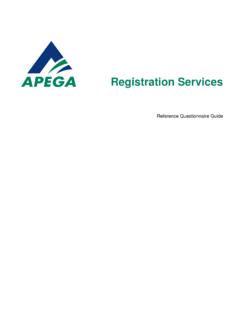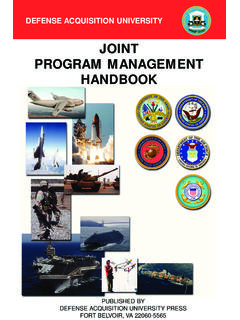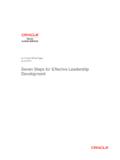Transcription of Continuing Professional Development Program - APEGA
1 Continuing Professional Development Program April 2014 The Association of Professional Engineers and Geoscientists of Alberta TABLE OF CONTENTS 1 INTRODUCTION .. 1 Professional Development in a Changing Professional Context .. 1 Application .. 1 2 EXEMPTION FROM THE Program .. 1 Conditions .. 1 Resuming Active Practice (Going Back to Practicing) .. 2 3 THE RECORDING/REPORTING PROCESS .. 2 CPD Requirements .. 2 Recording Activities .. 2 Reporting Annually .. 3 Verifying the CPD Activities .. 3 4 MINIMUM REQUIREMENTS .. 3 Numerical & Diversity Requirements .. 3 Categories .. 3 Professional Practice .. 4 Formal Activity .. 4 Informal Activity .. 4 Participation .. 5 Presentations .. 5 Contributions to Knowledge .. 5 Summary .. 6 Carryover of PDHs .. 7 Part-time Employment or Unemployment .. 7 Members on Dues Deferment .. 7 Unemployed/Parental-Maternity Leave.
2 7 Health/Disability .. 7 Members in Full-time Educational programs .. 8 Members in Management Positions .. 8 Working Out-of-Province .. 8 5 ROLE OF THE EMPLOYER .. 9 6 CONSEQUENCES OF NON-COMPLIANCE .. 9 7 FURTHER INFORMATION .. 10 APPENDIX I - NON-PRACTICING DECLARATION .. 11 APPENDIX II - DETAILED ACTIVITY RECORD (Blank form) .. 12 APPENDIX III - DETAILED ACTIVITY RECORD (Examples) .. 13 APPENDIX IV - REQUEST FOR SPECIAL CONSIDERATION .. 26 1 1 INTRODUCTION Professional Development in a Changing Professional Context In the interests of protecting the health, safety and welfare of the public, it is essential for professionals to engage in lifelong learning. Society's expectations have changed, and the public is demanding greater accountability from professionals. That is why, in 1997, APEGA Council established the Continuing Professional Development (CPD) Program . The General Regulations under the Engineering and Geoscience Professions Act require that all Professional members and licensees comply with the CPD Program .
3 Mandatory Continuing Professional Development is common in many professions. In most provinces, the engineering and geoscience regulatory organizations have moved towards mandatory requirements. APEGA 's CPD Program establishes an annual process and a minimum benchmark of effort. The minimum requirements may not be adequate to maintain or increase competence, so it is up to you to assess your own needs and to plan appropriately. Recognizing the diversity of APEGA members, the Program provides the flexibility for you to undertake activities that provide the greatest benefit to you in the practice of your profession. Application The Program applies to all Professional members, licensees and Professional licensees. It does not apply to students, exam candidates or members-in-training. If you are newly registered as a Professional member, licensee or Professional licensee, the requirement to engage in Professional Development activities begins on the date of your registration.
4 2 EXEMPTION FROM THE Program Conditions If you file a written declaration stating that you are not actively engaged in the practice of engineering or geoscience ( , "non-practicing"), you are exempt from the requirements of the Program . You cannot practice in Alberta while the declaration (exemption) is in effect, but you may continue to use your Professional designation since you are still a member and remain bound by the Act, Regulations, By-Laws and Code of Ethics. You may not act as a Responsible Member for an APEGA Permit to Practice. If your work meets the legal definition of engineering or geoscience, or if you have technical influence over the professions, you are considered to be engaged in the practice and cannot be exempted by declaring yourself as non-practicing. The legal definitions of the practices of engineering and geoscience appear in Appendix I, along with the Non-Practicing Declaration.
5 2 If you continue to influence the practice of engineering or geoscience in a broader sense, you may file a non-practicing declaration, but you are encouraged not to. Non-practicing declarations are subject to verification. An exemption created by a non-practicing declaration is effective for one year from the date the declaration is received by APEGA , but may be renewed for additional yearly periods. To continue the exemption, you must submit a new declaration annually. Resuming Active Practice (Going Back to Practicing) If you have filed a non-practicing declaration, you must immediately notify the Practice Review Board in writing if you intend to resume practicing and request an application for resumption of practice. On considering the application, the Practice Review Board may require you to comply with certain conditions that it might set prior to allowing you to resume practicing.
6 When you have received the Board's permission to resume active practice, you are required to engage in Professional Development activities beginning on your resumption date. Currently, if you have been exempted from the Program for two years or less, there are no conditions to be met. If you have been registered in another jurisdiction during the time when an exemption is in effect, there are also no conditions, regardless of the length of time you have been exempt. In any case, you are still required to notify APEGA as noted above. 3 THE RECORDING/REPORTING PROCESS A successful plan for Continuing Professional Development should consider your scope of practice and duties, your current level of knowledge and skills, your short term needs and objectives, as well as long range plans. You should select meaningful activities that will be of benefit to your practice.
7 They should have a clear purpose and objective that will maintain, improve or expand the skills or knowledge in pursuit of your chosen field. CPD Requirements To meet the requirements of the Continuing Professional Development (CPD) Program , you are required to: 1. maintain a written record of CPD activities, 2. report your CPD hours annually, and 3. submit the detailed activity record on request (using the form in Appendix II). Recording Activities You are required to maintain a detailed record of your Professional Development activities. The Detailed Activity Record spreadsheet in Appendix II (and available on APEGA 's Web site) may be helpful. Several examples are given in Appendix III. You must retain your records for at least three years. Your detailed activity record must include the following information for each "membership year" related to your membership renewal date: 3 the date(s) the activity occurred a description/title of the activity the organizer/provider of the activity (if applicable) the CPD category in which the activity belongs the number of Professional Development Hours (PDHs) you claimed for the activity The number of hours in the detailed log must support the hours you submitted on your CPD Annual Report.
8 Reporting Annually Along with the annual dues invoice, you will receive a reminder to report your hours online using the Member Self-Service Centre on APEGA s home page at You are required to indicate only the number of PDHs you claimed for your Professional Development activities in the 12 months previous to your membership renewal date. Verifying the CPD Activities APEGA 's Practice Review Board is responsible for administering the Continuing Professional Development Program . It may ask to review your Professional Development activities in detail. In that regard, you should retain documents to verify attendance at courses, seminars, etc. in case you are asked to produce those. In the event of a review, you will be asked to submit your Detailed Activity Records for the previous three years. The detailed information should match the categories and hours you claimed in the CPD Annual Reports you had submitted previously.
9 Failure to produce the detailed record of activities within 30 days notice can result in your being struck from the membership register. You will be advised as to the outcome of the review, whether your activities comply with the requirements of the Program , or whether some modification is necessary, or whether the Board requires that a review of your practice be conducted. 4 MINIMUM REQUIREMENTS Numerical & Diversity Requirements A credible Program must define minimum levels of effort. The unit of measure for this effort is a Professional Development Hour (PDH). There is flexibility in terms of the number of Professional Development categories, the period over which the minimums must be attained and the carry-forward provisions. The requirements are as follows: You must maintain a total of at least 240 PDHs over three years. You must include activities in at least three of the six categories.
10 You cannot claim more than the maximum PDHs allowed annually in each category. Categories The following are the six categories in which you may earn credit for Professional Development : Professional Practice Formal Activity 4 Informal Activity Participation Presentations Contributions to Knowledge Professional Practice Active Professional practice is a significant factor in maintaining and improving your skills, either where you are actually practicing according to the legal definition (see Appendix I) or influencing the practice of the professions. "Influencing" means having some effect on how the professions are practiced without necessarily performing technical work. 15 hours of work equals one PDH. A maximum of 50 PDHs per year may be claimed in this category. Formal Activity You should strive to include some formal activities in your Continuing Professional Development Program .







